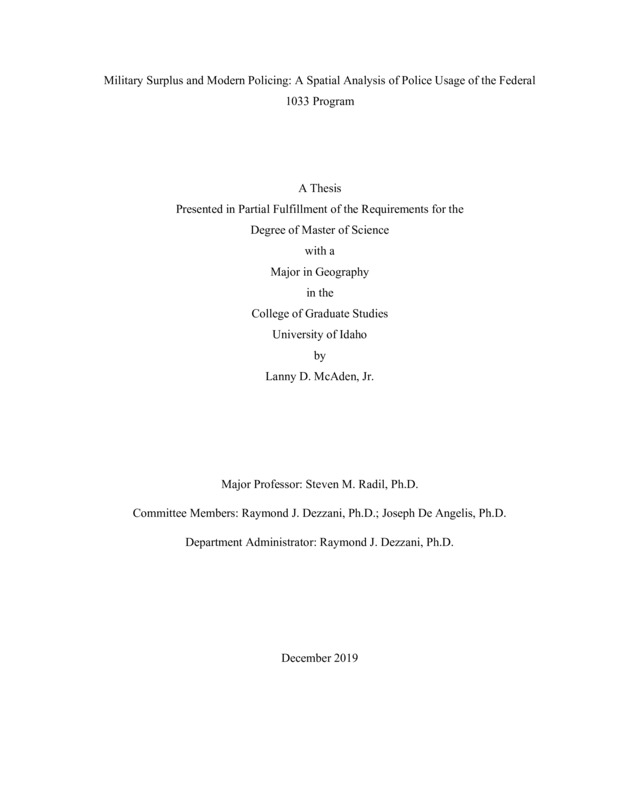Military Surplus and Modern Policing: A Spatial Analysis of Police Usage of the Federal 1033 Program
McAden, Lanny Dean. (2019-12). Military Surplus and Modern Policing: A Spatial Analysis of Police Usage of the Federal 1033 Program. Theses and Dissertations Collection, University of Idaho Library Digital Collections. https://www.lib.uidaho.edu/digital/etd/items/mcaden_idaho_0089n_11740.html
- Title:
- Military Surplus and Modern Policing: A Spatial Analysis of Police Usage of the Federal 1033 Program
- Author:
- McAden, Lanny Dean
- ORCID:
- https://orcid.org/0000-0002-2471-9998
- Date:
- 2019-12
- Keywords:
- Geographically weighted regression Militarization Policing Political geography Spatial analysis
- Program:
- Geography
- Subject Category:
- Geography
- Abstract:
-
While there have been long-running concerns over police militarization in the United States, the aggressive police response to the 2014 protests in Ferguson, Missouri heightened public awareness of the issue. As a result, the police acquisition and use of military-style equipment has come under increasing scrutiny, as have the programs which provide police access to such equipment. The 1033 program, which provides military surplus to civilian police, is perhaps the most important and controversial such program, and participation in 1033 is often seen as an indicator of the adoption of military-like practices by police. This study is situated to build upon previous geographic work on the police militarization and the 1033 program (Radil, Dezzani, and McAden, 2017) by exploring those contextual influences of place on Law Enforcement Agency (LEA) decision making. This previous research showed that participation in the 1033 program has been highly regionalized and proposed that local and regional contexts have important explanatory value. To build on this, three groupings of contextual elements of place were identified as having the greatest potential to influence LEAs, and consisted of; socioeconomic contexts, measurable political and legal factors, and measures of LEA structure and activity. To deal with the spatial variation present in these local and regional contexts, a geographically weighted regression (GWR) model was used to explore the influence of place on LEA decisions to participate in the 1033 program. The highly regionalized findings in this study deviated from the common global argument for why police become militarized. This deviation supports the need for further spatial research into not only police militarization but policing in general.
- Description:
- masters, M.S., Geography -- University of Idaho - College of Graduate Studies, 2019-12
- Major Professor:
- Radil, Steven M
- Committee:
- Dezzani, Raymond J; De Angelis, Joseph
- Defense Date:
- 2019-12
- Identifier:
- McAden_idaho_0089N_11740
- Type:
- Text
- Format Original:
- Format:
- application/pdf
- Rights:
- In Copyright - Educational Use Permitted. For more information, please contact University of Idaho Library Special Collections and Archives Department at libspec@uidaho.edu.
- Standardized Rights:
- http://rightsstatements.org/vocab/InC-EDU/1.0/

